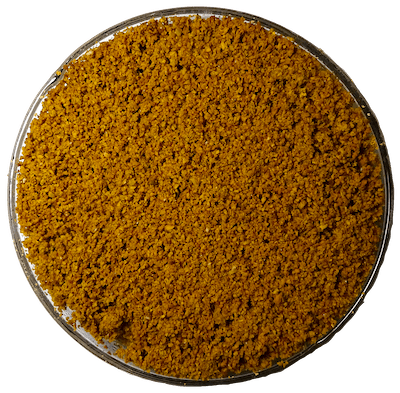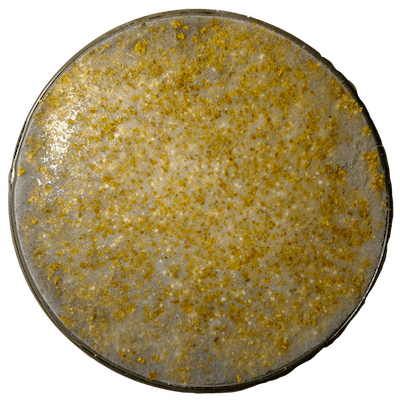Acorn tempeh. Using Rhizopus fermentation to reduce tannin content?

ˬ˯vᐯ˅ˇ⌣ᘁ᥎ ᨆ ⏝ࡍ⩗ᨆ⌣˘ˬ᥎ᐯᨆ⌣ᘁ⩗ᨆࡍ˯
This post is from Mésange, my weekly ‘popup’ newsletter, from October 2022 to March 2023. < Previous | Next >
Last week I was telling you that acorns have been eaten by humans for thousands of years, using several strategies to reduce the content of their main antinutrient — tannins. As you may know, fermentation is also an effective way of reducing antinutrients.
Then, it reminded me of tempeh!
As Indonesian people do with soybean, we can ferment legumes, grains, or nuts with a fungus called Rhizopus. It grows like on cheese, as a white filament — mycelium — binding the grains altogether and digesting some antinutrients. We call this tempeh.
I have already shared some of my explorations with soy okara tempeh and chickpea tempeh.
Curiously, I haven’t found any food blog or scientific article about acorn tempeh in French, English, Spanish, and Chinese! It is indeed a bit paradoxical: microorganisms can reduce antinutrients through fermentation, but some antinutrients like tannins are precisely antimicrobial.
So, maybe acorn tempeh just cannot work?
Let’s try to investigate this!
Dear Rhizopus, would you like to grow in acorn okara?
I start a discussion with acorns and Rhizopus.
I hope they can teach me what is the most natural way for them to interact. Like in a dance, I propose a movement (method), I listen to their replies (results), and I try to adjust another movement (conclusions and next trial).
I start the first experiment. A first movement.
Method
I shell acorns, leaving the thin seed coat, because it is too difficult to remove. Manual shelling of acorns is a long process. I try to see it as an invitation to meditate…
Following the practice of native North Americans, I grind acorns into a thin powder of ~ 1 mm. Fermentation can work better if particles are small. Instead of a mortar and pestle, I use a blender, adding a minimal amount of water for it to pulverize properly. This will already leach some of the tannins into the water.
Then, I separate the solid and liquid parts using a cheesecloth. I press until no water drips from the acorn okara. Rhizopus likes about 20% of moisture, but this is difficult to readily measure. So, I just press until it reminds me of a good moisture level from my previous discussions with Rhizopus. Moist but not wet.
At this point, I realize this creamy liquid part could be called “acorn milk”.
I taste it.
It is super astringent! Well, it means it works: this milk contains some leached tannins.
I keep my ground acorn uncooked. For some reason, it seems I recently developed a kind of aversion to sterilizing everything! Instead of trying to kill the “germs”, I am more excited by trying to adjust the “terrain”: substrate, moisture, oxygen, temperature, time.
As I don’t cook acorns, it is hence as if I recruit every voluntary microorganism, and invite them to work in a team with Rhizopus. I propose myself as an orchestra conductor for this symphony, or a fermentation conductor, adjusting the parameters. I hope they will like it.
Yet, I still over-inoculate, that is, I put a lot of Rhizopus spores — its seeds—, thus clearly proposing to Rhizopus to be the soloist of this movement. This way, if Rhizopus doesn’t grow, I will know it is not due to a lack of spores.
I put the inoculated ground acorn in glass Petri dishes.
From previous trials, I know that Petri dishes provide an appropriate amount of oxygen for tempeh-making.
Results & discussions
After 12 hours, I don’t see any mycelium. But I don’t worry.
It is common not to see anything at this time, but I should be able to smell something. I bring my nose close to one opened Petri dish. Yes! It works, the smell is changing, some fermentation happens here!
After 48 hours, though, still no mycelium in sight. Oh no, I feel sad, it failed.
At this point, the fermentation should be completed, and the white mycelium should cover every piece of ground acorn.
I smell: pleasant, fruity, vinegar. Yes, something definitely has happened. I taste: acidic, still astringent but much less.
Okay, so Rhizopus hasn’t grown, but my taste tells me that tannins have indeed been reduced, and my smell tells me that the main musicians might have been some bacteria from the Acetobacter genus, that is, the ones able to make vinegar — acetic acid.
I realize that these bacteria might be the best at growing within tannins, like they do in wine vinegar or in kombucha.
Conclusions
Here is what my micro-colleagues seem to tell me.
For bacteria from the Acetobacter genus, dealing with tannins looks natural. For Rhizopus, however, dealing with tannins looks painful.
Ok, sorry Rhizopus! It must have felt quite awkward to be asked to play as a soloist while you don’t really master tannins.
If you don’t mind, I propose another movement…
Dear Rhizopus, are there too many tannins?
Let’s try to start with a liquid-state fermentation first. Perhaps it could reduce enough tannins for Rhizopus to grow better?
Method
I make acorn milk like last time, but then, I let it ferment for 24 hours at room temperature 15-20°C (60-70°F).
After 24h, I separate acorn okara from acorn milk, using a cheesecloth. I over-inoculate this raw okara with Rhizopus spores, and I put this mixture into Petri dishes.
This time, though, I also make a “control”, that is, I put raw acorn okara into Petri dishes without Rhizopus spores. This is to check what happens if I just let acorn okara evolve spontaneously.
Results & discussions
After 24 hours, small bubbles appear in the acorn milk.
Yes! Some fermentation is happening.
The smell is fresh like yogurt, meaning that lactic bacteria might have worked.
It also smells a bit like sourdough, meaning that some yeasts might have worked too. Yeasts may be the ones making the bubbles.
After 48 hours of tempeh growing in the acorn okara, no mycelium though. Nothing grows. Oh, no!
And the “control” Petri dishes smell fresh, fruity, vinegar. Some fermentation is occurring there.
Conclusions
I start to realize how powerful those tannins are. They really prevent my fungus Rhizopus from developing. Tannins seem to be like salt or a lack of oxygen: they strongly control fermentation.
A first liquid-state fermentation of 24 h was perhaps too short to remove enough tannins for tempeh making.
But, there is still another potential problem: is there too much competition for Rhizopus? Am I too extreme when, instead of a sterile monoculture of Rhizopus, I am more excited by a symphony of microbes?
Ok, sorry again Rhizopus. If you don’t mind, I propose another movement…
Dear Rhizopus, is there too much competition?
Let’s try to reduce tannins even more before inviting Rhizopus. And let’s try to cook the acorn okara first, to check if Rhizopus would prefer to be alone.
Method
This time, I remove the tannin-rich seed coat while shelling, to try to reduce tannins as much as I can.
This time, I leach four times the acorn okara with cold water, and I discard the water, to make sure I remove a lot of tannins. Below is the leached water, 1st round on the left, 4th one on the right.
And this time, I also propose three different compositions:
- Raw acorn okara. That is, the “control”, where I invite any volunteer microbe to play.
- Raw acorn okara + Rhizopus spores. That is, my beloved song, where Rhizopus plays as a soloist, accompanied by a choir of volunteer microbes.
- Steamed acorn okara + Rhizopus spores. Here, all the musician microbes are dead, and Rhizopus has to make it alone, a cappella.
And, for each of these three compositions, I launch three replicates. That is, we repeat the composition three times, in three different auditoriums, or rather three Petri dishes. This is to make sure what I observe is a real trend that occurs each time.
Do you also feel I am becoming more rigorous? Or even more rigid?
Let’s hope I will not have to propose a 4th movement, otherwise, I might start to ask to my poor musicians for a randomized double-blind placebo-controlled symphony.
Results & discussions
After 12 hours, some tiny white threads are developing in some of the Petri dishes. Mold! Bravo!
After 48 hours:
Control — No mycelium is visible in the “control” Petri dishes.
But no bad smell is either detectable there.
I taste, and the astringency is very very low.
Cooked — A cappella, that is, when Rhizopus was growing alone on the cooked acorn. It has developed, but interestingly in a less even manner than usual. I am not sure why. Perhaps because the steaming process dried the acorn okara a bit too much? The smell is fruity, ester-like, alcoholic. Exactly the fragrance we obtain when making tempeh from starchy grains.
Conclusions
To remove tannins from ground acorn, a punk fermentation, like what happened in the “control” Petri dishes, seems a simple, safe, and efficient track to pursue.
Rhizopus’ expertise is not about playing with tannins. We need to reduce tannins’ content using one way or another, before inviting her (or him?) to make acorn tempeh.
Rhizopus can sing a cappella to make acorn tempeh — that is, as a monoculture on sterlized ground acorn. The result is actually very fragrant.
But Rhizopus is not against diversity and collaboration either. Surrounded by volunteer microbes kindly tolerated by the fermentation conductor, Rhizopus might grow even better. The resulting smell from such a collaboration is then completely different, and kind of enigmatic.
This is, hence, calling for more movements, to go deeper in feeling and understanding this mysterious world of micro-friends!
And, by the way, is it tasty?
I tried to fry and steam these two kinds of tempeh.
After cooking, both have a pleasant fried mushroom flavor, like soy tempeh, and even some umami taste.
For the one cooked before fermentation, the texture is soft but it tastes a bit more acidic. For the one raw before fermentation, the texture is crispier, we feel fibers, but we don’t feel any acidity.
Overall, they still have some astringency, maybe not more than red wine, but I would probably prefer fewer tannins.
- Previous experiment (9/26) : Acorns, tannins, and humans. Preparing acorns as food
- Next experiment (11/26): Literary wanderings


